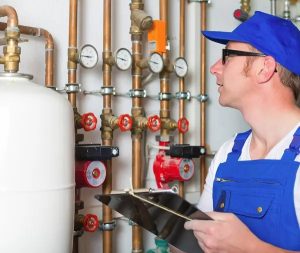Table Of Contents
The toilet cistern not filling up correctly is a common problem among homeowners. It can become quite problematic when you notice that your toilet tank never holds the exact amount of water necessary for a proper flush. Therefore, flushing the toilet more than once may be necessary to clean the bowl.
If you’re someone with good plumbing skills, this problem won’t be a big deal for you, and you’ll be able to solve it on your own. But if you are not an expert in plumbing, then don’t hesitate to hire a professional plumber to handle it properly. By doing so, you can save both your precious time and money.
In this article, you will get to know the top reasons why your toilet cistern is not filling up correctly and some appropriate solutions which might be helpful. Read on!
Check Why Your Toilet Cistern Is Not Filling Up
Open the shut-off valve
The first thing to do if you have an issue with your toilet’s tank not filling up is to check if the shut-off valve is open. It should be on the toilet’s back wall. Turn it counter clockwise to open it.
A push/pull valve is seen on some toilets. To turn the water, supply on to the toilet, turn the valve handle in. It’s a simple solution, but if you don’t know where to look or what to search for, your toilet won’t fill up after the first flush.
Re-adjust the float ball
A float ball or a float cup or cylinder is built in your toilet. Float balls are typically seen in older toilet types, whereas float cups are present in newer toilets and are much smaller.
One of the most common causes of this cistern problem is the float ball in toilet cisterns. The float ball helps stop the flow of water by adjusting the float arm when the water level in the tank reaches the optimal balance. This prevents excess water from entering the tank. The toilet tank does not obtain enough water supply when the float ball is too low.
To adjust the toilet float ball:
- Switch the water supply to the toilet off by turning off the shut-off valve at the back of the toilet. If your toilet has a push or pull valve present, turn it clockwise or pull it out.
- Hold the lever down long enough to flush the toilet and remove most of the water.
- Remove the toilet tank lid and keep it someplace safe.
- Check whether you have a float ball or a float cup.
- If the fill valves have a float ball, you have to look for a screw where the float arm links to the fill valve. Turn this screw clockwise using a screwdriver to raise the water level in the toilet tank.
- Look for a long plastic screw attached to and alongside the float in a float cup. To raise the water level in your toilet tank, turn it clockwise with a screwdriver.
- Do not overtighten the screws while making the modifications. Turn the water supply on and off until the water level is half inches below the overflow tube.
- Replace the lid on the toilet tank.
Adjust the fill valve
If the toilet cistern still does not fill as it should after adjusting the float ball, the problem could be with the fill valves. The toilet cistern valves are in charge of managing the flow of water from the supply line to the tank during flushing. If your toilet’s fill valves have float arms, start by removing the lid’s cap. Next, find the fill valve’s angle, which is usually on the left.
Then insert a flat-head screwdriver into the adjustment screw. The fill valves are raised by turning them clockwise. More water will be able to flow into the toilet cistern as a result of this. Turn the screw counter clockwise and lower the fill valves if the tank demands less water. After making these modifications, flush your toilet and check to see if the water fills appropriately.
If your toilet tank has adjustable cylinders, repeat the process of locating the fill valve on the left side of the tank. Then press the float clip against the valve’s side. Slide it up to let in additional water or down to let out less.
Avoid faulty trip assembly
A malfunctioning trip assembly could also be the cause of your toilet cistern not filling up correctly. The trip assembly is a part of the flush’s handle. In turn, the flush is connected to the tank. It’s possible that this assembly isn’t in the best place or blocking itself while the lid is closed. The flush cycle will be shortened as a result of this.
Open the lid and examine the trip assembly to resolve the problem. If you find that the trip assembly is broken, bent, or worn out, you should consider replacing it. You can only resolve this filling issue by changing the trip assembly.
Replace the toilet flapper
If your toilet isn’t filling, but the water is running, the issue may be with the flapper. A toilet flapper is a rubber seal located at the base of the toilet tank. This opens to allow flush water to enter the toilet bowl and closes to allow the toilet tank to fill up and hold water for the next flush.
A lift chain is used to link the flapper to the toilet handle. A one-and-a-half-centimetre slack in the chain is preferable. The flapper is going to unseat if the chain is too tight or attaches to another element of the toilet tank. As a result, your toilet will never fill up and will run continually.
When the lift chain’s end is dangling loosely inside the toilet tank, this can be an issue. It may enter the flapper hole after flushing, causing the flapper to be unable to seal correctly. After that, you’ll have a toilet that won’t stop running and won’t flush.
Also, minerals like calcium and debris in the water can sometimes accumulate under the toilet flapper and on the flush valve hole. As a result, the flapper will not close properly, resulting in a running toilet and an empty toilet tank. You should resolve the issue by running water through the flush valve and flapper.
To replace a toilet flapper:
- Turn off the toilet’s water supply. The shut-off valve is located behind your toilet’s cistern. Make a clockwise turn.
- To remove as much water as possible, flush the toilet and hold the lever down.
- Remove the toilet cover and store it in a safe place.
- You should unhook the lift chain from the handle arm.
- Lift the flapper off the overflow tube by removing the pegs that hold it in place.
- Thoroughly clean the area where the new flapper will be installed.
- Connect the pegs to the overflow tube and install the new flapper.
- The lift chain should be connected to the handle arm.
- Turn on the toilet’s water supply.
- Make sure the toilet tank isn’t overflowing and that there aren’t any leaks.
- Replace the lid on the toilet tank.
Remove any bricks from the area
To preserve water flow, some individuals place a small block or some other heavy object in toilet cisterns. This is not good for your toilet’s safety, and if you did the same thing or utilised a heavy object, you should get rid of it immediately. It’s most likely the source of the toilet tank’s lack of water for flushing. By doing so, a toilet cistern will be blocked. It’s possible that, as a result, the tank will also be affected.
Prevent blockages in waste lines
An obstruction in the vent or waste pipe could be the source of the toilet flushing issue. It’s as simple as plunging the toilet or clearing the central vent. If there is adequate water flow from the tank into the toilet bowl, you can achieve this by spraying some water into the entrance of the vent. It is advised to employ a professional plumber to investigate the problem so that whatever is blocking the water pipe will be removed appropriately.
Overflow tube replacement
The toilet overflow tube is basically a long tube in the toilet tank’s centre that conducts surplus water down to the toilet bowl in order to prevent overflowing. The overflow tube can crack, which causes the water in the tank to flow down to the toilet bowl continuously. If your toilet isn’t filling yet, this could be the problem.
Overflow tubes are not difficult to replace. You will be required to remove the existing one and replace it in the flush valve base. Ensure that the flow tube you purchase is the proper size. If you want, the entire flush valve can be replaced (which the overflow is a part of).
Low water pressure
Low water pressure could be the likely cause of your toilet cistern not filling correctly. If this is the case, it is not a big problem. You can deal with this minor annoyance pretty quickly.
This usually happens when your old toilet lines corrode or leak, preventing enough water from flowing into the cistern. Your home may be an older structure with faulty piping. This will cause issues with your plumbing fittings, particularly your toilet.
Pay Attention To Serious Plumbing Issues
These are some of the severe issues that will negatively impact your toilet cisterns and prevent them from filling up as they should. If you follow the instructions highlighted in this article carefully, your toilet cistern can be adequately filled with water in no time. Don’t let a malfunctioning toilet cistern disrupt your regular routine, as the toilet is quite an essential feature of any household.
It can leave your home in an uncomfortable state if it is not in good working order. The cistern is often where the breakdown begins and concludes. The toilet tank, float ball, float arm, flush handle control, and every switch used to operate the toilet are all placed in the cistern. Therefore, it is vital to get a professional plumber to fix it if you are not someone with plumbing skills.











